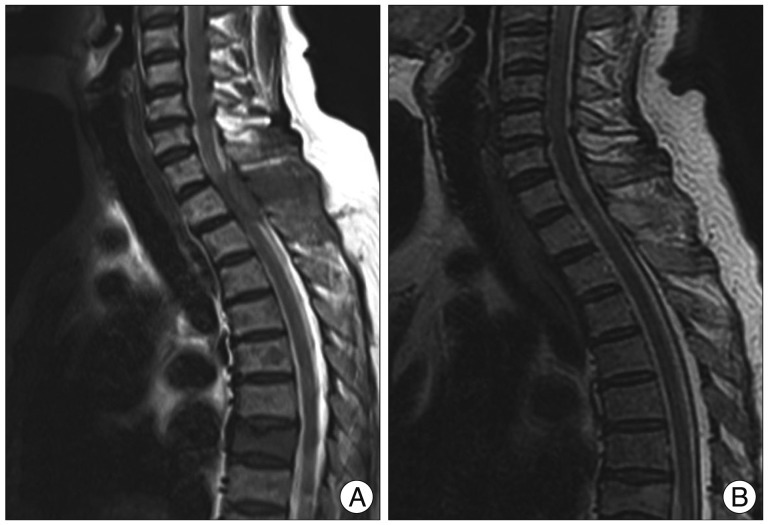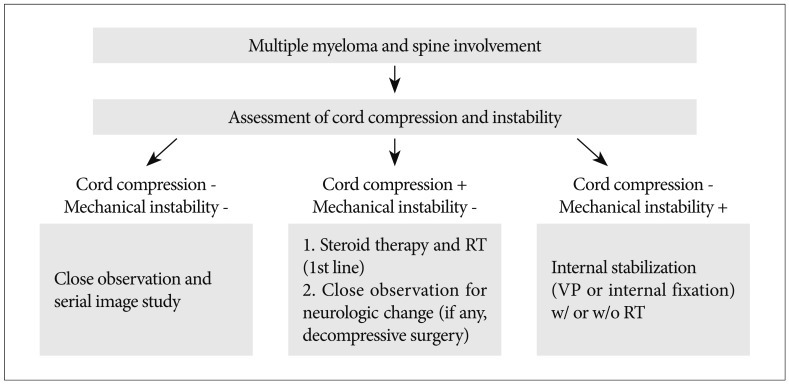1. Avadhani A, Shetty AP, Rajasekaran S. Isolated extraosseous epidural myeloma presenting with thoracic compressive myelopathy. Spine J. 2010; 10:e7–e10. PMID:
20189464.

2. Benson WJ, Scarffe JH, Todd ID, Palmer M, Crowther D. Spinal-cord compression in myeloma. Br Med J. 1979; 1:1541–1544. PMID:
466107.

3. Damaj G, Mohty M, Vey N, Dincan E, Bouabdallah R, Faucher C, et al. Features of extramedullary and extraosseous multiple myeloma : a report of 19 patients from a single center. Eur J Haematol. 2004; 73:402–406. PMID:
15522061.

4. Dürr HR, Wegener B, Krödel A, Müller PE, Jansson V, Refior HJ. Multiple myeloma : surgery of the spine : retrospective analysis of 27 patients. Spine (Phila Pa 1976). 2002; 27:320–324. discussion 325-326. PMID:
11805699.
5. Innes J, Newall J. Myelomatosis. Lancet. 1961; 1:239–245. PMID:
13717759.

6. Jin R, Rock J, Jin JY, Janakiraman N, Kim JH, Movsas B, et al. Single fraction spine radiosurgery for myeloma epidural spinal cord compression. J Exp Ther Oncol. 2009; 8:35–41. PMID:
19827269.
7. Lim BS, Chang UK, Youn SM. Clinical outcomes after percutaneous vertebroplasty for pathologic compression fractures in osteolytic metastatic spinal disease. J Korean Neurosurg Soc. 2009; 45:369–374. PMID:
19609421.

8. Lourbopoulos A, Ioannidis P, Balogiannis I, Stavrinou P, Koletsa T, Karacostas D. Cervical epidural plasmacytoma presenting as ascending paraparesis. Spine J. 2011; 11:e1–e4. PMID:
21498133.

9. Matsui H, Fujie H, Tsuji H. Extraosseous epidural tumor of immunoglobulin D myeloma. J Spinal Disord. 1992; 5:366–369. PMID:
1520997.

10. Okacha N, Chrif E, Brahim E, Ali A, Abderrahman E, Gazzaz M, et al. Extraosseous epidural multiple myeloma presenting with thoracic spine compression. Joint Bone Spine. 2008; 75:70–72. PMID:
17905632.

11. Palmbach M, Hoffmann W, Grodd W, Postler E, Voigt K. Extraosseous, epidural tumour spread of multiple myeloma. Eur J Radiol. 1996; 22:146–148. PMID:
8793437.

12. Prestwich RJ, Ackroyd S, Gilson D. Is surgery required in the management of spinal cord compression in myeloma patients? Clin Oncol (R Coll Radiol). 2011; 23:161. PMID:
21216573.

13. Rades D, Huttenlocher S, Dunst J, Bajrovic A, Karstens JH, Rudat V, et al. Matched pair analysis comparing surgery followed by radiotherapy and radiotherapy alone for metastatic spinal cord compression. J Clin Oncol. 2010; 28:3597–3604. PMID:
20606090.

14. Rades D, Veninga T, Stalpers LJ, Basic H, Rudat V, Karstens JH, et al. Outcome after radiotherapy alone for metastatic spinal cord compression in patients with oligometastases. J Clin Oncol. 2007; 25:50–56. PMID:
17194905.

15. Renier JC, Brégeon C, Boasson M, Audran M, Emile J, Guy G, et al. [Spinal cord compression in multiple myeloma Study of 10 cases]. Rev Rhum Mal Osteoartic. 1984; 51:193–196. PMID:
6729378.
16. Wadleigh M, Tefferi A. Classification and diagnosis of myeloproliferative neoplasms according to the 2008 World Health Organization criteria. Int J Hematol. 2010; 91:174–179. PMID:
20191332.

17. Wallington M, Mendis S, Premawardhana U, Sanders P, Shahsavar-Haghighi K. Local control and survival in spinal cord compression from lymphoma and myeloma. Radiother Oncol. 1997; 42:43–47. PMID:
9132825.








 PDF
PDF ePub
ePub Citation
Citation Print
Print




 XML Download
XML Download